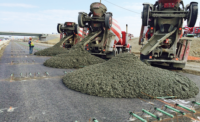Concrete Monitoring Speeds London Airport Expansion

Sensors track concrete temperatures, while an AI-based engine calculates strength.
PHOTO COURTESY BAM NUTTALL

Sensors track concrete temperatures, while an AI-based engine calculates strength.
PHOTO BY PETER REINA FOR ENR

Converge co-founders Gideon Farrell and Raphael Scheps see a future in sensors.
PHOTO BY PETER REINA FOR ENR



At the King George the Fifth dock site on the River Thames, a contractor is using smart sensors to monitor the strength of concrete it’s casting to form 75,000 sq meters of slab over water to extend the footprint of London City Airport.
About 250 wireless sensors are being embedded to send temperature data to the cloud so engineers can continuously monitor the strength of the concrete as it cures.
Under a contract signed for $111 million two years ago, BAM Nuttall Ltd. (BAMN) is placing a generally 18-cm-thick slab on a base of precast planks and beams supported by more than 1,000 piles, set 10 m apart in the dock water.
Using the real-time monitoring system, BAMN can load newly cast sections of slab days before conventional cube test results would allow, says project manager Dan Russell. The systems is “constantly updating predictions based on air temperature readings. … Strength prediction can vary day to day,” says Russell.
The contractor is embedding on average two sensors in each 500-sq-m placement. Setting up the site to use the system “takes a bit of time,” adds Russell. “But once that’s done, it’s done.”
The data is flowing to the site from the startup firm, Converge, located some 10 km upstream in an office building in Blackfriars. Physicists Raphael Scheps and Gideon Farrell set up Converge six years ago to exploit the use of distributed, wireless sensors in industrial operations. The two met at Cambridge University and spent some years apart in various digital businesses before launching the firm and raising $4.6 million from startup investors. Converge is raising another $5.2 million, says Scheps, now CEO.
“We were looking generally at the use of sensors to optimize complex systems” says Scheps. The two were drawn to construction and its intensely manual methods of concrete monitoring. Making sample concrete cubes or cylinders, storing them in conditions unlike those on site and crushing them to test strength, seemed archaic to the entrepreneurs.
The industry “is huge and the scale and opportunity to make a big difference was just enormous,” says Farrell, the company’s chief technical officer.
After some chance meetings with Converge executives, BAMN decided to run a trial of the company’s original system at a London project in 2016, says Colin Evison, the contractor’s head of innovation. That system generates real-time strength data with immediate calculations using the well established Maturity Method.
Last year, the contractor and Converge secured a government grant covering about 60% of an 18-month, $1.4-million project to develop strength-prediction capability. To do this, Converge acquired artificial intelligence software that uses weather forecast information, along with the huge volume of concrete data it has accumulated from some 200 projects.
“Engineers are able to start anticipating concrete behavior on site and not just reacting to it,” says Scheps. “[The tool] keeps learning,” he adds. “The more data we get, the more accurate our platform becomes.” Converge charges $650 to $3,275 per month for its service.
Having introduced the system at London City Airport, BAMN will also use it on a large seawall repair job involving some 200 time-critical concrete pours in Devon, says Evison. While the contractor values the added efficiency provided by Converge’s system, “for us it’s a bigger story of how we can start to employ this technology more,” says Evison. The industry is only “starting to scratch the surface” of real-time monitoring, he adds.
Catching Up After Earlier Project Delays
While the sensors at London City Airport are saving time on critical pours, the project is still trying to recover from early delays, when the owner’s design firm, TPS Consult Ltd., ceased work. TPS pulled out in early 2018 when its owner Carillion plc, went bust. Many weeks were lost as TPS’s replacement, Atkins, reviewed and revised the design.
But possible delays caused by emerging World War Two unexploded bombs have so far not materialized. Numerous bombs were targeted at the dock during the war and many failed to detonate. A survey of each pile location managed by the project delivery partner Bechtel unearthed one 500 kg device in early 2018. No more have since emerged.





